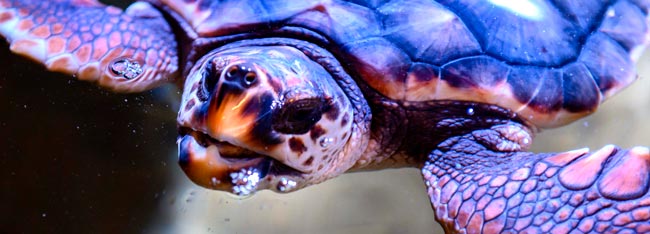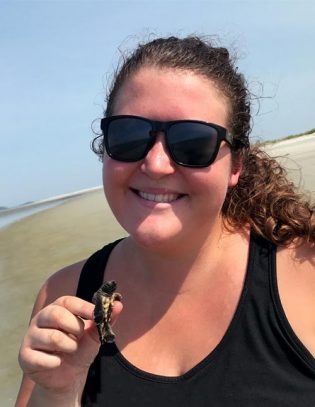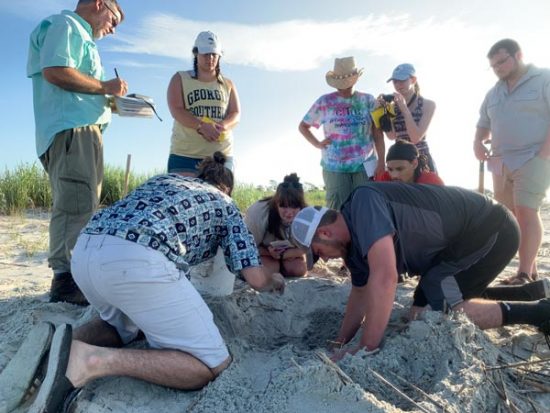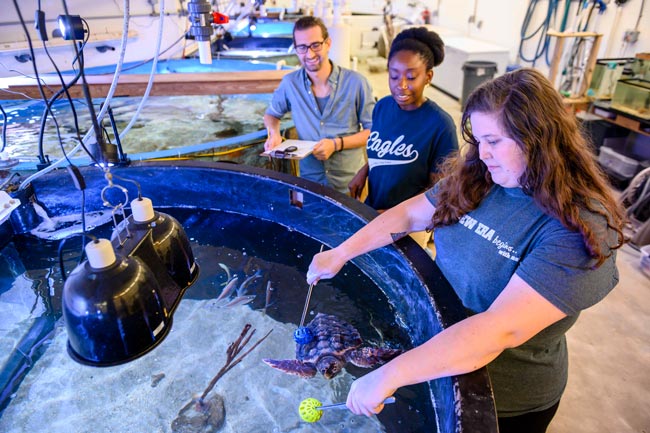Protecting the Nest

Georgia Southern Plays Role in Growing Sea Turtle Populations

It’s before dawn on St. Catherines Island in Liberty County, Georgia, but Sydney Davis is already wide awake and ready to embark on an adventure through the uninhabited island.
Davis joins a group of students and researchers by climbing onto an ATV to navigate through unsettled woods, dimly lit marshes and pristine beaches. On the beach, Davis and her peers have their eyes peeled, looking for disturbances in the sand and dune areas that indicate a sea turtle has made its way to the beach to lay a nest.
“It really feels like we are investigating a mystery,” said Davis, a graduate student at the university and volunteer with the Georgia Southern University Sea Turtle Program at St. Catherines Island (STP@SCI).
Davis and her peers will go on this adventure daily from May to October during sea turtle nesting season to help solve the mystery of where a mother sea turtle has chosen to lay her nest. Once the nest is discovered, the real investigation begins to find the eggs.
The team “reads” the crawlway and nest to locate the egg chamber; then, carefully uses a shovel to uncover the egg chamber by removing a few inches of sand at a time. Next, the nest is assigned a number and if it’s location is too low on the beach, teams will relocate it higher up on the dunes to avoid threats like tidal washout from storms, high tides and sea-level rise. Almost 20 feet of beach is lost each year on St. Catherines, so many nests must be moved to help increase the survival rate of hatchlings.
The privately-owned, 22,000-acre island is also home to native and invasive species that prey on sea turtle hatchlings, including feral hogs, armadillos and northern raccoons, so moving the nest and providing a protective screen on the top is crucial to the survival of eggs and hatchlings.
“We protect the nests from being washed over or washed out by relocating the entire clutch of eggs to an area of higher elevation in a dune system stabilized by vegetation,” said Jaynie Gaskin, MPH, co-director of the STP@SCI. “Because St. Catherines is the most erosional island on the Georgia coast, we relocate a higher percentage of our sea turtle nests than most of the other barrier islands.”

Once the nests are safely relocated, they are monitored every day. After about 50 or 60 days, hatching begins beneath the sand, and the baby sea turtles dig their way to the surface to begin their journey to the sea.
“We know we have been successful in our conservation efforts when we see little tiny sea turtle crawlways coming from the nest and headed toward the ocean,” Gaskin said.
After hatchlings have made it to the waters, they’ll swim for about 72 hours as they make their way to the Gulf Stream. From there, they swim out to the open ocean and will hopefully survive to adulthood and return to St. Catherines to lay their own nests.
“Researchers believe that out of every thousand sea turtle hatchlings, only one turtle will survive to adulthood and reproductive maturity,” she said.
It takes 30 to 35 years for loggerhead sea turtles to reach reproductive maturity, and though they don’t nest every year, they can lay up to eight nests in a season in a lifespan that can reach 90 years. Since the program’s inception in 1990, Gaskin estimates that more than 300,000 hatchlings on St. Catherines have made it to the sea. In 2019, more than 25,000 hatchlings from 350 nests made it to the sea, which is the most ever recorded in the program’s nearly 30-year history. This is why Gaskin and her fellow researchers believe the 2019 season was so successful.
“We believe those hatchling turtles saved 30 years ago by the early conservation efforts are now coming back to St. Catherines to nest,” Gaskin said. This is why conservation efforts like the STP@SCI are so important. All species of sea turtles are either threatened or endangered, and some even face extinction.
“By increasing the number of sea turtle hatchlings we release into the ocean every year, we are tipping the scales in the turtles’ favor and increasing the number of turtles that will survive to adulthood,” said Gaskin.
Sponsored by the Department of Geology and Geography, the sea turtle program on St. Catherines is one of many across the state that works in cooperation with the Georgia Department of Natural Resources, but it’s the only program in Georgia run by a university. In addition to their conservation efforts, the researchers and scientists are also passing along these practices to a new generation, like Davis, an applied geography graduate student who has been involved with the program since she was an undergraduate.
Originally a pre-med major on her way to medical school, Davis’ advisor suggested this class as a fun and unique experience to end her undergraduate career. After one summer on the island, her plans for post-undergrad changed.
“This program completely changed my life,” she said. “Without this program, I would never have known that people were still doing fieldwork like this.”
In addition to her work with the field school, Davis has gone back to St. Catherines as a volunteer and is currently completing her master’s thesis research with the program.
Every year, the program hosts a conservation-focused field school with topics that include biology, ecology, geology, sustainability, wildlife management and environmental science for undergraduate and graduate students of Georgia Southern University. Founded by Geology Professor Emeritus Gale A. Bishop, the school was first opened to teach scientific inquiry to Georgia’s K-12 school teachers.
Co-Director and Professor of Geology Robert Kelly Vance expanded the scope of the field school to offer more experiences for university students, including the opportunity to earn eight credit hours for their participation. The STP@SCI’s educational programs have provided valuable hands-on experiential learning to nearly 300 teachers and more than 100 undergraduate students through fully-immersive field-based courses and internships.
“Sea turtles have been studied for decades, and I was shocked by how many questions researchers and conservationists still have,” said Davis, who participated as an undergraduate. “The course showed me that field research is still such an important part of science. People are still out on beaches, every day of the season, collecting data on every single nest a sea turtle lays on our Georgia beaches. After realizing all of this, I felt a responsibility to help answer those questions.”
As the only university-based field school in Georgia, the sea turtle field school provides students experience in field-based learning and science, where they must develop observational skills, scientific documentation and critical thinking skills. Gaskin said the faculty see a lot of maturing happen during this experience.
“The hands-on experience really builds a strong sense of responsibility in our students,” she said. “In no other class are they going to be responsible for protecting and saving an endangered species.”
— Crissie Elrick Bath

Helping Turtles Survive in the Wild
Helping protect sea turtle nests, eggs and hatchlings isn’t the only way students and researchers at Georgia Southern are contributing to sea turtle conservation.
Students in the College of Behavioral and Social Sciences’ Department of Psychology on the Armstrong Campus are assisting researchers at the UGA Aquarium on Skidaway Island with studying environmental enrichment for loggerhead sea turtles as part of an animal husbandry program before they’re released back into the wild.
“Oftentimes with organisms in managed care facilities, animals tend to engage in non-species specific behaviors that aren’t adaptive in their natural environment,” said Andrew Bulla, Ph.D., professor of psychology and faculty mentor to students.
“With sea turtles in managed care facilities, you may see some stereotypes like an abundance of resting behavior, or that they are top feeding with their beaks out of the water, all of which are things we don’t tend to see out in the wild.”
With environmental enrichment, Bulla said, the captive environment in which the turtles live mimics their natural habitat, which increases their chances for survival once released. It also provides valuable data for researchers and hands-on experience for students in the psychology field. They’re learning to problem solve and practicing analytical thinking as they’re recording data and then making sense of their observations.
“What we see more and more is that animal-based models of learning are going away in undergraduate programs,” said Bulla. “For these students to have the opportunity to do research not only with animals using behavior analysis, but nontraditional animals such as marine animals, it really makes them a unique candidate for graduate school training, internships and careers.”
— Crissie Elrick Bath
